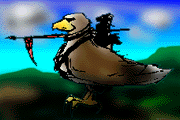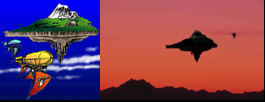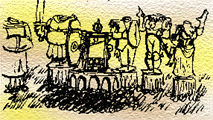


 |  |  |
|---|
| ||
|---|---|---|
 Rahktors are giant avians that are capable of flying at very high altitudes, and can even be found nesting on some of the sky islands, though they are too large to be found "wild" on Rephidim itself. They are large enough to be used as aerial mounts ... or to be very pesky predators capable of carrying off livestock (and people). Some of the Knight Templars of Rephidim utilize Rahktors as mounts, since any assault on Rephidim by external forces would invariably require airborne attacks. Rahktors are giant avians that are capable of flying at very high altitudes, and can even be found nesting on some of the sky islands, though they are too large to be found "wild" on Rephidim itself. They are large enough to be used as aerial mounts ... or to be very pesky predators capable of carrying off livestock (and people). Some of the Knight Templars of Rephidim utilize Rahktors as mounts, since any assault on Rephidim by external forces would invariably require airborne attacks.
| ||
 This exotic liquid from the Himaat is peculiar in that it is made up of several flourescent colors of the rainbow which will swirl about but never actually blend together. The water is quite poisonous to most species, but to the mutant Nohbakim, it is a strong intoxicant. This exotic liquid from the Himaat is peculiar in that it is made up of several flourescent colors of the rainbow which will swirl about but never actually blend together. The water is quite poisonous to most species, but to the mutant Nohbakim, it is a strong intoxicant.
| ||
| ||
| Rath'ani are raccoon anthropomorphs found on Sinai, a mostly "civilized" race found in urban areas, intermixed with other races. They are known for having particularly dextrous hands and tend toward technical and craft trades. There may be no statistical evidence for the stereotype, but they're also believed to have a high incidence of nervous breakdowns and mental imbalances, especially later in life -- and they tend to have fairly long lifespans. (But then, this could also be due to the fact that, being mostly city-dwellers in technical trades, they may simply have a higher standard of life, as a racial average, than most.) | ||
| Razorworms are small, wiggly and quite voracious pests that have a taste for wood, and which live in the Sea of Sand of the Himaat Desert. They are a considerable hazard for sand-ships, as they can find their way through the sand toward wood at a fairly fast pace, and can eat through wood nearly as quickly. The best way to deal with them is by locating bore-holes in an infected ship and dousing the worms with poison as quickly as possible. | ||
 The Red Cliffs are a recently created geological feature in the Himar region, an after-effect of the strange device known as the Boomer, dropped on Elamoore by Babelite terrorists. As witnesses attest, Elamoore and its surrounding region simply vanished, replaced by a large chunk of red earth and rock. Trees, houses and other objects at the rim of this "replaced" area have been cleanly sliced right at the border, resulting in such phenomena as houses that have been halfway replaced by rock. The Red Cliffs are a recently created geological feature in the Himar region, an after-effect of the strange device known as the Boomer, dropped on Elamoore by Babelite terrorists. As witnesses attest, Elamoore and its surrounding region simply vanished, replaced by a large chunk of red earth and rock. Trees, houses and other objects at the rim of this "replaced" area have been cleanly sliced right at the border, resulting in such phenomena as houses that have been halfway replaced by rock. The Red Cliffs form a high plateau that is nearly impossible to scale by most land-bound creatures without the assistance of airships. (Winged creatures, of course, have a distinct advantage.) Rumor has it that the top of the plateau is littered with huge chunks of ruined metal machinery, making this area a target of treasure-hunters from all over the globe. Rumor also has it that magic is suppressed or even nonexistent here, and that this may be a new Forbidden Zone. | ||
| ||
| (obscure information outside of Ashdod and religious circles) Rephath is a matron of vigilantes, and myths involving her of course deal with matters of revenge, being routinely quite violent. At times, officials of Ashdod have attempted to portray Rephath in a more positive light as a matron of law enforcement officials, but this is only done by completely ignoring the particulars of established mythos. Rephath is traditionally depicted as a grey female Eeee - idealized as with most Babelite goddesses - with hair bound back in a long braid, and dyed markings in her fur, including variations upon her personal rune. She is often shown holding a set of scales, typically tipped to one side, and she is also often depicted with a large, double-bladed axe. | ||
| ||
| (not common knowledge outside of Babel or religious circles) According to the myth of the Birth of the Seven Sisters, this name (which means "mercy" in Babelite) is the former name of Rephath, Goddess of Vengeance, before she and her sisters rebelled against and slew Bael, the Creator God. | ||
| Rephidim Standard is the language of the Temple and of Rephidim, and thus is in wide use across all of Sinai. In many nations, even those with native tongues, it is common for citizens there to learn Rephidim Standard as a second language. All Exiles who are taken to the Temple for Processing are taught Rephidim Standard. So far as can be told, Rephidim Standard has remained in its current form, virtually unchanged, for many millenia, purportedly since the time of the Expedition (0 RTR). Part of this is due to the Temple's stabilizing influence, and part of it is through the Learning Helmet training given to Exiles -- The language taught by the helmet is unchanged all these millenia, and therefore it is an unchanging standard. Individual terms and jargon may be introduced, of course, but the basic structure of the language and core words have remained unchanged. Still, there are instances of "offshoots" from Rephidim Standard, especially during the earliest days of Rephidim's history, before the age of widespread exploration and travel of Sinai by means of airship. Some isolated colonies -- free from the stabilizing influence of the Temple -- would develop on their own, and the language accordingly would diverge as well. Some call these "spin-off" languages "archaic Rephidim Standard", somewhat erroneously, therefore. | ||
| ||
 The largest of the sky islands on Sinai is Rephidim, which houses a sizeable city of the same name. The city of Rephidim is dominated by a theo-bureaucracy based in the Temple, its emblem being that of the Star and Anchor. The largest of the sky islands on Sinai is Rephidim, which houses a sizeable city of the same name. The city of Rephidim is dominated by a theo-bureaucracy based in the Temple, its emblem being that of the Star and Anchor.Rephidim is the most technologically advanced of any of the known Sinai cultures, largely due to the fact that magic is suppressed by approximately 75% (by most measures) here, and that technology is more reliable than down on the surface of the world. While Rephidim is a bustling city, it is also home to well-entrenched corruption and crime. The seediest portion of the city is referred to as Darkside, and is almost a city unto itself. At an altitude of 10,000 feet ASL, the air is thin and cold ... but due to a localized phenomenon, the atmosphere immediately around Rephidim is breathable and of a moderate temperature. In essence, the area around Rephidim is a permanent weather front, and its arrival as it meanders across Sinai is often heralded by storms on the surface. | ||
 A major landmark of Gallis, located in the city of Fleaufille, is Revolution Square, which enshrines a guillotine (with a metal blade) responsible for the ends of the reigns of the last uncountable number of leaders of Gallis. It is seen as a symbol of freedom, the rising up of the oppressed against the oppressors, etc. Statues surround the guillotine, representing various former heads of state ... minus their heads, that is. A major landmark of Gallis, located in the city of Fleaufille, is Revolution Square, which enshrines a guillotine (with a metal blade) responsible for the ends of the reigns of the last uncountable number of leaders of Gallis. It is seen as a symbol of freedom, the rising up of the oppressed against the oppressors, etc. Statues surround the guillotine, representing various former heads of state ... minus their heads, that is.
| ||
| ||
| For Rhian PCs, it is recommended that you have at least 2 points allocated to Strength ("Stronger than Average" -- Major, Novice). Rhians also have a -1 Disadvantage: Vegetarian. | ||
| ||
| (not common knowledge outside Babel and religious circles) According to popular Babelite myths such as The Birth of the Seven Sisters, Rinala (sometimes translated as "Life", "Immortality" or "Perpetual Life") was the name of the goddess who eventually became Sunala ("Death") when she and her sisters rebelled against and murdered the creator-god, Vael. However, less well known is that there are some theories that Rinala was in fact a predecessor of sorts to the pleasure goddess Inala -- That, long ago in Babel's history, two deities formed a sort of creative/destructive duality, one (Rinala) representing life, and the other (Sunala) representing death. The festivals of Rinala were concerned with fertility and life, and traditionally became intertwined with rituals of courtship, a practice that eventually caused the festivals to be more associated with love -- to the point that the concept of Rinala was originally changed into Dinala ("Love"). From there, the festivals built around the celebration of love turned into hedonistic binges, and what evolved from that was that the goddess of "Love" eventually became Inala ("Pleasure"). Priestesses of Inala would, of course, find this history of the development of their religion to be utterly blasphemous, and this is not anything taught openly in Babel about the origins of their goddesses. | ||
| Rituals are the mainstay of magic-users on Sinai. While they require considerably more time and preparation (and often cost) than weaker incantations such as a Cantrip or Minor Spell, they are also considerably more potent. It is for spells of this level that mages are typically best known, since only at this level do such magicks begin to have real practical use and power. A standard requirement of any ritual-level spell is to have some sort of "magic circle", which the spellcaster typically sits in the center of. The exact nature of the circle can vary greatly with the particular spell, the sphere of magic being used, and even the individual spellcaster's "style". Ultimately, if one were to, say, have some layman exactly mimic the words uttered by a mage, and recreate a ritual perfectly, it would not cause magic to occur. The ritual is a mental tool, the nature of which is not fully understood even by mages themselves. More powerful mages tend to be able to make shorter rituals to achieve the same results. Since it is inconvenient, say, to have a Fire Mage ask some bandits to kindly pause while he casts a Fireball spell, it is a common practice for more experienced mages to use "held spells". In a theoretical situation with a Fire Mage undertaking a hazardous journey, the mage would cast the spell in the morning, right up to the last word. The magic of the spell would manifest itself in the form of, say, a magical flame dancing about in his off hand. If needed, at some point later in the day, he could fire off the last word of his spell, and release the stored energy. (A hazard of this is that, under certain circumstances, such as the mage being knocked unconscious, the spell's power might go off a bit prematurely. Caution is advised.) | ||
| ||
 "Rokuga" refers to a group of races found in the Nagai Empire's holdings in the Savan Territories. They have in common that they are reptilian in form, sapient, and possess a total of six limbs (some combination of arms, legs and/or wings), most often humanoid or near-humanoid. "Rokuga" refers to a group of races found in the Nagai Empire's holdings in the Savan Territories. They have in common that they are reptilian in form, sapient, and possess a total of six limbs (some combination of arms, legs and/or wings), most often humanoid or near-humanoid.The plural of "Rokuga" is either "Rokugas" or "Rokugai" (used when referring to the collective "race" as a whole). | ||
 The Sanctuary of Roses is based in Rephidim, among the Sanctuaries at Golgotha, at the base of the central mountain. It looks like a cross between fortification and greenhouse, and is the base of the Magenta Lance. It is not a tourist attraction by any means, due to its relative inaccessibility, but among florists, it is revered for having an impressive collection of roses of all known varieties found on Sinai, as well as several (believed to have been somehow brought in by Exiles or perhaps generated by magical means) not found elsewhere. The Sanctuary of Roses is based in Rephidim, among the Sanctuaries at Golgotha, at the base of the central mountain. It looks like a cross between fortification and greenhouse, and is the base of the Magenta Lance. It is not a tourist attraction by any means, due to its relative inaccessibility, but among florists, it is revered for having an impressive collection of roses of all known varieties found on Sinai, as well as several (believed to have been somehow brought in by Exiles or perhaps generated by magical means) not found elsewhere.
|
| Home Page |
Player Guide |
Log Library |
Recent Logs |
|---|---|---|---|
| Encyclopedia |
Dramatis Personae |
Art Gallery |
Moz Ezley Asylum |